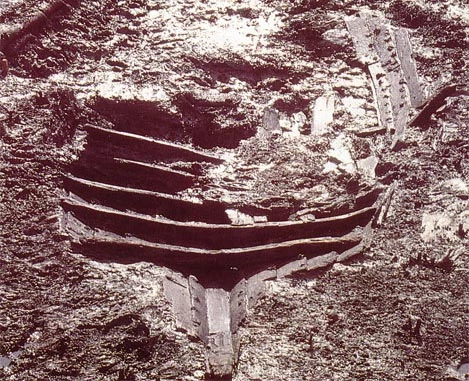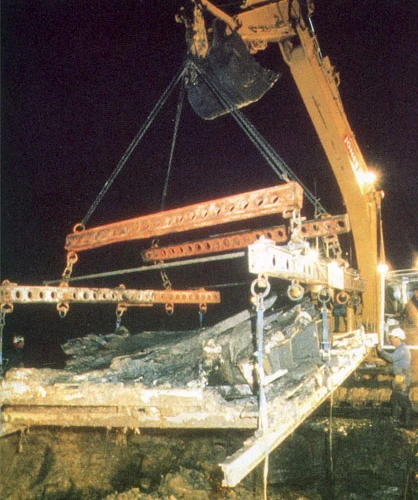Medieval boat discovered in south Wales estuary
The remains of the boat in the mud
Raising the boat from the mud 4.00am August 27th 1995
A reconstructed model of the Boat
In 1994, the remains of a boat were discovered in the thick mud on the Gwent Levels, south Wales. Tests on the timber revealed that the boat dated from around 1194. Further excavation revealed that an intact portion of the vessel, 7.2m long and 3.9m wide, survived, making it the most important boat find of the Middle Ages in Britain for 25 years.
Lifting the Wreck
Recovery of the wreck was essential, but it could either be dismantled on site, or recovered intact. Dismantling could only be done in controlled conditions. However, the wreck was only accessible at low tide for a few hours at a time. The only reasonable course of action therefore was to retrieve the vessel intact.
Outside assistance in lifting the wreck was provided from the company building the nearby Second Severn Crossing, and over a period of seven tidal windows, day and night, a team of people worked tirelessly to dig tunnels underneath the vessel to build a cradle of aluminium beams. Extreme care had to be taken as the poor condition of the wreck made it vulnerable to disintegration.
The cradle was then attached to a lifting crane, the cables tightened, and the remaining sediment dug out. The vessel was successfully lifted at 4.00 in the morning before being transported to Cardiff, where it was placed in water to prevent the wood rotting further.
The remains were recorded and dismantled with each timber being drawn individually. The vessel was carrying iron ore at the time of sinking so had to be thoroughly cleaned using water and soft brushes to remove the iron salts from the ancient remains.
Since it was hoped that the boat could be displayed in its original form at the Museum, the timbers had to be conserved either in a way that would allow reshaping after conservation, or be moulded to shape before conservation. Both these methods have advantages and disadvantages:
Conserving the ancient wood
Waterlogged wood is conserved using a water-soluble wax, this means either immersing the timbers for five to ten years in a concentrated solution before being slowly dried in air; or immersed in a more dilute solution followed by freeze-drying to remove the water, producing a 'dry' product within one to two years.
The first method results in an object that is more wax than timber, with a non-wood like appearance, but the large amount of wax allows reshaping of the timbers. Freeze drying, on the other hand, produces a material which still has the appearance of wood as the amount of wax is much lower. However, the timbers are much more brittle than those treated by the first method and it is not possible to reshape the timbers.
Creating a Model of the boat
It was decided to reshape the timbers into their original form before conserving the wood and so a full-size model of the surviving structure had to be built to work out what the final shape of the timbers should be.
The model had to accurately replicate in three dimensions the lay-out and shapes of all the surviving timbers. The model could then provide a set of moulds to be constructed to shape and hold the planking during conservation.
After the remains were successfully reshaped, the timbers were conserved using the wax and freeze-drying treatment. The dried and stabilised timbers are now safely in the collections of Amgueddfa Cymru and research on the vessel continues, helping to place this important find within its historical context.



Comments - (2)
Hi,
Thank you for getting in touch and for your enquiry. The boat discussed in the article are the fragmentary remains of a small medieval boat generally referred to as the Magor Pill Boat. The surviving timbers are now safely preserved and stored at the Museum’s Collection Centre at Nantgarw. As far as I am aware there are currently no plans for its display.
There is also the much larger and better preserved medieval ship found in Newport itself, which is in the care of Newport Museum. More details about this ship and the progress of this project can be found on the website of the Friends of the Newport Ship https://www.newportship.org/
I hope this answers your question.
Kind regards,
Evan Chapman
(Senior Curator: Archaeology & Numismatics)